Associations of Human Cognitive Abilities with Elevated Carbon Dioxide Concentrations in an Enclosed Chamber
Abstract
:1. Introduction
2. Methods
2.1. Participants
2.2. Environmental Conditions
2.3. Cognitive Tests
- (1)
- Reaction time (RT) tests (perception)
- (2)
- Speed perception test (perception)
- (3)
- Visual search (VS) test (attention)
- (4)
- 2-back test (short-term working memory)
- (5)
- Balloon analogue risk test (BART) (risky decision-making)
- (6)
- Stroop test (executive ability)
2.4. Experimental Procedure
2.5. Statistical Analysis
3. Results
3.1. Perception
3.2. Attention
3.3. Short-Term Working Memory
3.4. Risky Decision-Making
3.5. Executive Ability
4. Discussion
4.1. Comparison with Previous Studies
4.2. Potential Mechanism Underlying the Cognitive Performance
4.3. Exposure Limit for CO2 Concentration in Workplaces
4.4. Limitation of This Study
5. Conclusions
Supplementary Materials
Author Contributions
Funding
Institutional Review Board Statement
Informed Consent Statement
Data Availability Statement
Acknowledgments
Conflicts of Interest
References
- IPCC. Climate change 2013: The physical science basis. In Contribution of Working Group Ⅰ to the Fifth Assessment Report of the Intergovernmental Panel on Climate Change; Boucher, O., Randall, D., Artaxo, P., Bretherton, C., Eds.; Cambridge University Press: Cambridge, UK, 2013. [Google Scholar]
- Abdel-Salam, M.M. Investigation of PM2.5 and Carbon Dioxide Levels in Urban Homes. J. Air Waste Manag. Assoc. 2015, 65, 930–936. [Google Scholar] [CrossRef] [PubMed] [Green Version]
- Fisk, W.J. The Ventilation Problem in Schools: Literature Review. Indoor Air 2017, 27, 1039–1051. [Google Scholar] [CrossRef] [PubMed] [Green Version]
- GIaconia, C.; Orioli, A.; Gangi, A.D. Air Quality and Relative Humidity in Commercial Aircrafts: An Experimental Investigation on Short-Haul Domestic Flights. Build. Environ. 2013, 67, 69–81. [Google Scholar] [CrossRef] [Green Version]
- Cao, X.D.; Zevitas, C.D.; Spengler, J.D.; Brent, C.; Eileen, M.N.; Byron, J.; Ming, L.S.; Piers, M.N.; Allen, J.G. The on-board carbon dioxide concentrations and ventilation performance in passenger cabins of US domestic fights. Indoor Built Environ. 2019, 28, 761–771. [Google Scholar] [CrossRef]
- Zhang, X.; Wargocki, P.; Lian, Z.; Tyregod, C. Effects of exposure to carbon dioxide and bioeffluents on perceived air quality, self-assessed acute health symptoms, and cognitive performance. Indoor Air 2017, 27, 47–64. [Google Scholar] [CrossRef] [PubMed] [Green Version]
- Zhang, X.; Wargocki, P.; Lian, Z. Human responses to carbon dioxide, a follow-up study at recommended exposure limits in non-industrial environments. Build. Environ. 2016, 100, 162–171. [Google Scholar] [CrossRef] [Green Version]
- Allen, J.G.; MacNaughton, P.; Cedeno-Laurent, J.G.; Cao, X.; Flanigan, S.; Vallarino, J.; Rueda, F.; Donnelly-McLay, D.; Spengler, J.D. Airplane pilot flight performance on 21 maneuvers in a flight simulator under varying carbon dioxide concentrations. J. Expo. Sci. Environ. Epidemiol. 2019, 29, 457–468. [Google Scholar] [CrossRef]
- Zhang, J.; Pang, L.P.; Cao, X.D.; Wanyan, X.R.; Wang, X.; Liang, J.; Zhang, L. The effects of elevated carbon dioxide concentration and mental workload on task performance in an enclosed environmental chamber. Build. Environ. 2020, 178, 106938. [Google Scholar] [CrossRef]
- Satish, U.; Mendell, M.J.; Shekhar, K.; Hotchi, T.; Sullivan, D.; Streufert, S.; Fisk, W.J. Is CO2 an indoor pollutant? Direct effects of low-to-moderate CO2 concentrations on human decision-making performance. Environ. Health Perspect. 2012, 120, 1671–1677. [Google Scholar] [CrossRef] [Green Version]
- Allen, J.G.; MacNaughton, P.; Satish, U.; Santanam, S.; Vallarino, J.; Spengler, J.D. Associations of cognitive function scores with carbon dioxide, ventilation, and volatile organic compound exposures in office workers: A controlled exposure study of green and conventional office environments. Environ. Health Perspect. 2016, 124, 805–812. [Google Scholar] [CrossRef] [Green Version]
- Rodeheffer, C.D.; Chabal, S.; Clarke, J.M.; Fothergill, D.M. Acute exposure to low-to-moderate carbon dioxide levels and submariner decision-making. Aerosp. Med. Hum. Perf. 2018, 89, 520–525. [Google Scholar] [CrossRef] [PubMed]
- Snow, S.; Boyson, A.S.; Paas, K.H.W.; Gough, H.; King, M.; Barlow, J.; Noakes, C.J.; Schraefel, M.C. Exploring the physiological, neurophysiological and cognitive performance effects of elevated carbon dioxide concentrations indoors. Build. Environ. 2019, 156, 243–252. [Google Scholar] [CrossRef]
- Liu, W.; Zhong, W.; Wargocki, P. Performance, acute health symptoms and physiological responses during exposure to high air temperature and carbon dioxide concentration. Build. Environ. 2017, 114, 96–105. [Google Scholar] [CrossRef] [Green Version]
- Bloch-Salisbury, E.; Lansing, R.; Shea, S.A. Acute changes in carbon dioxide levels alter the electroencephalogram without affecting cognitive function. Psychophysiology 2000, 37, 418–426. [Google Scholar] [CrossRef] [PubMed]
- Maddalena, R.; Mendell, M.J.; Eliseeva, K.; Chan, W.R.; Sullivan, D.P.; Russell, M.; Satish, U.; Fisk, W.J. Effects of ventilation rate per person and per floor area on perceived air quality, sick building syndrome symptoms, and decision-making. Indoor Air 2015, 25, 362–370. [Google Scholar] [CrossRef]
- Haverinen-Shaughnessy, U.; Shaughnessy, R.J. Effects of Classroom Ventilation Rate and Temperature on Students’ Test Scores. PLoS ONE 2015, 10, 255–262. [Google Scholar] [CrossRef]
- Bakó-Biró, Z.; Clements-Croome, D.J.; Kochhar, N.; Awbi, H.B.; Williams, M.J. Ventilation rates in schools and pupil’s performance. Build. Environ. 2012, 48, 215–223. [Google Scholar] [CrossRef]
- Twardella, D.; Matzen, W.; Lahrz, T.; Burghardt, R.; Spegel, H.; Hendrowarsito, L.; Frenzel, A.C.; Fromme, H. ffect of classroom air quality on student’s concentration: Result of a cluster-randomized cross-over experimental study. Indoor Air 2012, 22, 378–387. [Google Scholar] [CrossRef]
- Scully, R.R.; Basner, M.; Nasrini, J.; Lam, C.; Hermosillo, E.; Gur, R.C.; Moore, T.; Alexander, D.J.; Satish, U.; Ryder, V.E. Effects of acute exposures to carbon dioxide on decision-making and cognition in astronaut-like subjects. NPJ Microgravity 2019, 5, 17. [Google Scholar] [CrossRef]
- Coley, D.A.; Greeves, R.; Saxby, B.K. The Effect of Low Ventilation Rates on the Cognitive Function of a Primary School Class. Int. J. Vent. 2007, 6, 107–112. [Google Scholar] [CrossRef]
- Deary, I.J.; Liewald, D.; Nissan, J. A free, easy-to-use, computer-based simple and four-choice reaction time programme: The Deary-Liewald reaction time task. Behav. Res. Methods 2011, 43, 258–268. [Google Scholar] [CrossRef] [PubMed] [Green Version]
- Heitz, R.P. The speed accuracy tradeoff: History, physiology, methodology, and behavior. Front. Neurosci. 2014, 8, 150. [Google Scholar] [CrossRef] [PubMed] [Green Version]
- Chen, S.G.; Wang, C.H.; Tian, Z.Q.; Jiang, T. Development and application of software product for speed perception test. Comput. Eng. Des. 2013, 1, 372–376. [Google Scholar]
- Treisman, A. Focused attention in the perception and retrieval of multidimensional stimuli. Percept. Psychophys. 1977, 9, 40–50. [Google Scholar] [CrossRef]
- Müller, H.J.; Krummenacher, J. Visual search and selective attention. Vis. Cogn. 2006, 14, 389–410. [Google Scholar] [CrossRef]
- Kirchner, W.K. Age differences in short-term retention of rapidly changing information. J. Exp. Psychol. 1958, 55, 352–358. [Google Scholar] [CrossRef]
- Gajewski, P.D.; Hanisch, E.; Falkenstein, M.; Thönes, S.; Wascher, E. What does the n-back task measure as we get older? Relations between working-memory and other cognitive functions across the lifespan. Front. Psychol. 2018, 9, 2208. [Google Scholar] [CrossRef] [Green Version]
- Lejuez, C.W.; Read, J.P.; Kahier, C.W.; Richards, J.B.; Ramsey, S.E.; Stuart, G.L.; Strong, D.R.; Brown, R.A. Evaluation of a behavioral measure of risk-taking: The Balloon Analogue Risk Task (BART). J. Exp. Psychol.-Appl. 2002, 8, 75–84. [Google Scholar] [CrossRef]
- Lejuez, C.W.; Aklina, W.M.; Zvolenskyb, M.J.; Pedulla, C.M. Evaluation of the Balloon Analogue Risk Task (BART) as a predictor of adolescent real-world risk-taking behaviours. J. Adolesc. 2003, 26, 475–479. [Google Scholar] [CrossRef]
- Stroop, J.R. Studies of interference in serial verbal reactions. J. Exp. Psychol. 1935, 18, 643–662. [Google Scholar] [CrossRef]
- Erdodi, L.A.; Sagar, S.; Seke, K.; Zuccato, B.G.; Schwartz, E.S.; Roth, R.M. The Stroop test as a measure of performance validity in adults clinically referred for neuropsychological assessment. Psychol. Assess. 2018, 30, 755–766. [Google Scholar] [CrossRef] [PubMed]
- Cao, X.D.; MacNaughton, P.; Cadet, L.R.; Laurent, J.G.C.; Flanigan, S.; Vallarino, J.; McLay, D.D.; Christiani, D.C.; Spengler, J.D.; Allen, J.G. Heart rate variability and performance of commercial airline pilots during fight simulations. Int. J. Environ. Res. Public Health 2019, 16, 237. [Google Scholar] [CrossRef] [PubMed] [Green Version]
- Sheehy, J.B.; Kamon, E.; Kiser, D. Effects of carbon dioxide inhalation on psychomotor and mental performance during exercise and recovery. Hum. Factors 1982, 24, 581–588. [Google Scholar] [CrossRef] [PubMed]
- Pang, L.P.; Zhang, J.; Cao, X.D.; Wang, X.; Liang, J.; Zhang, L.; Guo, L. The effects of carbon dioxide exposure concentrations on human vigilance and sentiment in an enclosed workplace environment. Indoor Air 2021, 31, 467–479. [Google Scholar] [CrossRef]
- Du, B.; Tandoc, M.C.; Mack, M.L.; Siegel, J.A. Indoor CO2 concentrations and cognitive function: A critical review. Indoor Air 2020, 30, 1067–1082. [Google Scholar] [CrossRef] [PubMed]
- Vehvilainen, T.; Lindholm, H.; Rintamaki, H.; Paakkonen, R.; Hirvonen, A.; Niemi, O.; Vinha, J. High indoor CO2 concentrations in an office environment increases the transcutaneous CO2 level and sleepiness during cognitive work. J. Occup. Environ. Hyg. 2016, 13, 19–29. [Google Scholar] [CrossRef] [PubMed]
- Zhang, J.; Cao, X.D.; Wang, X.; Pang, L.P.; Liang, J.; Zhang, L. Physiological responses to elevated carbon dioxide concentration and mental workload during performing MATB tasks. Build. Environ. 2021, 195, 107752. [Google Scholar] [CrossRef]
- McEwen, B.S. Physiology and Neurobiology of Stress and Adaption: Central Role of the Brain. Physiol. Rev. 2007, 87, 873–904. [Google Scholar] [CrossRef] [Green Version]
- Alexander, C.S.; Hanns-Christian, G. Methodology in Human Physiology in Extreme Environments; Academic Press: London, UK, 2015. [Google Scholar]
- Lan, L.; Lian, Z. Application of statistical power analysis—How to determine the right sample size in human health, comfort and productivity research. Build. Environ. 2010, 45, 1202–1213. [Google Scholar] [CrossRef]
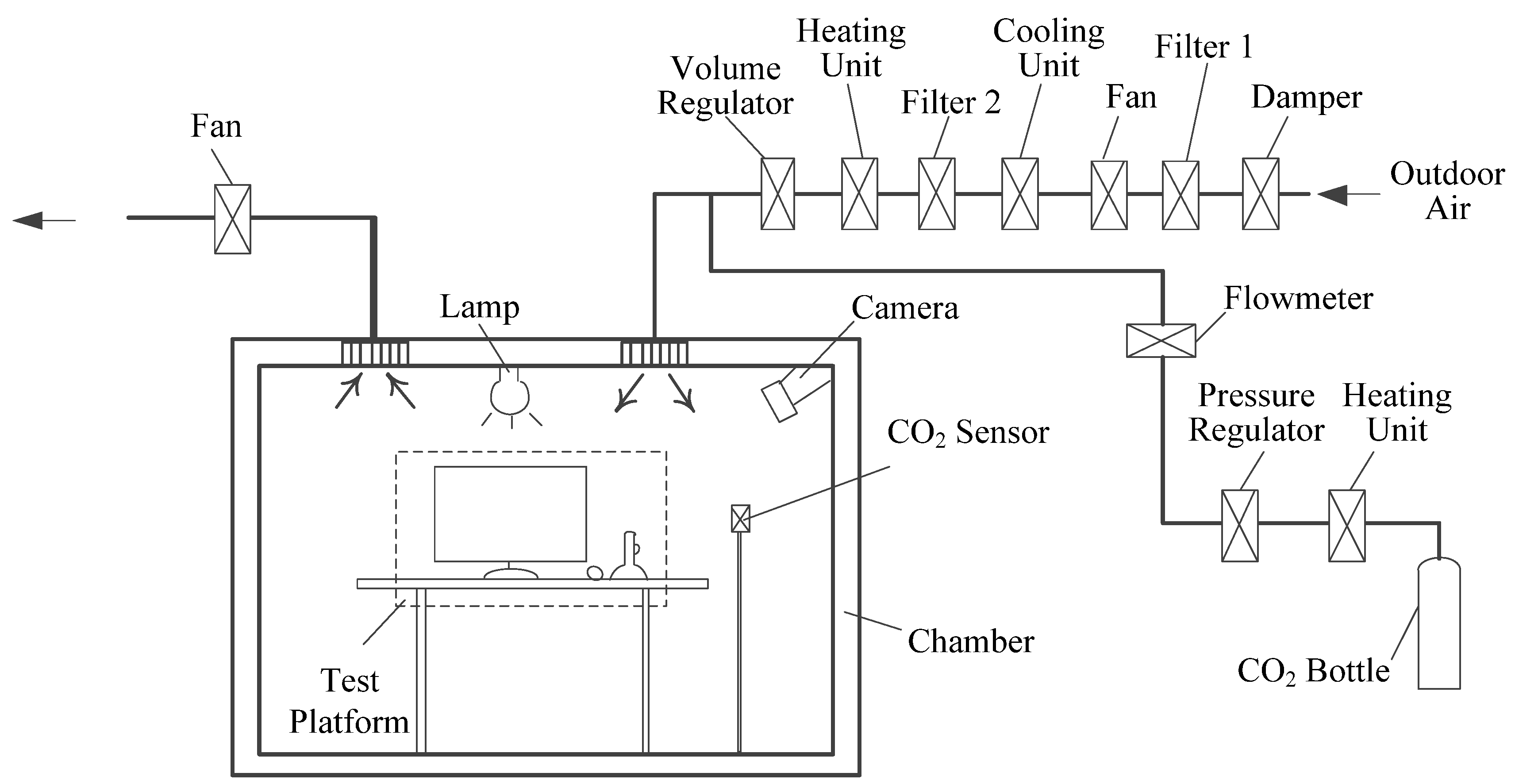


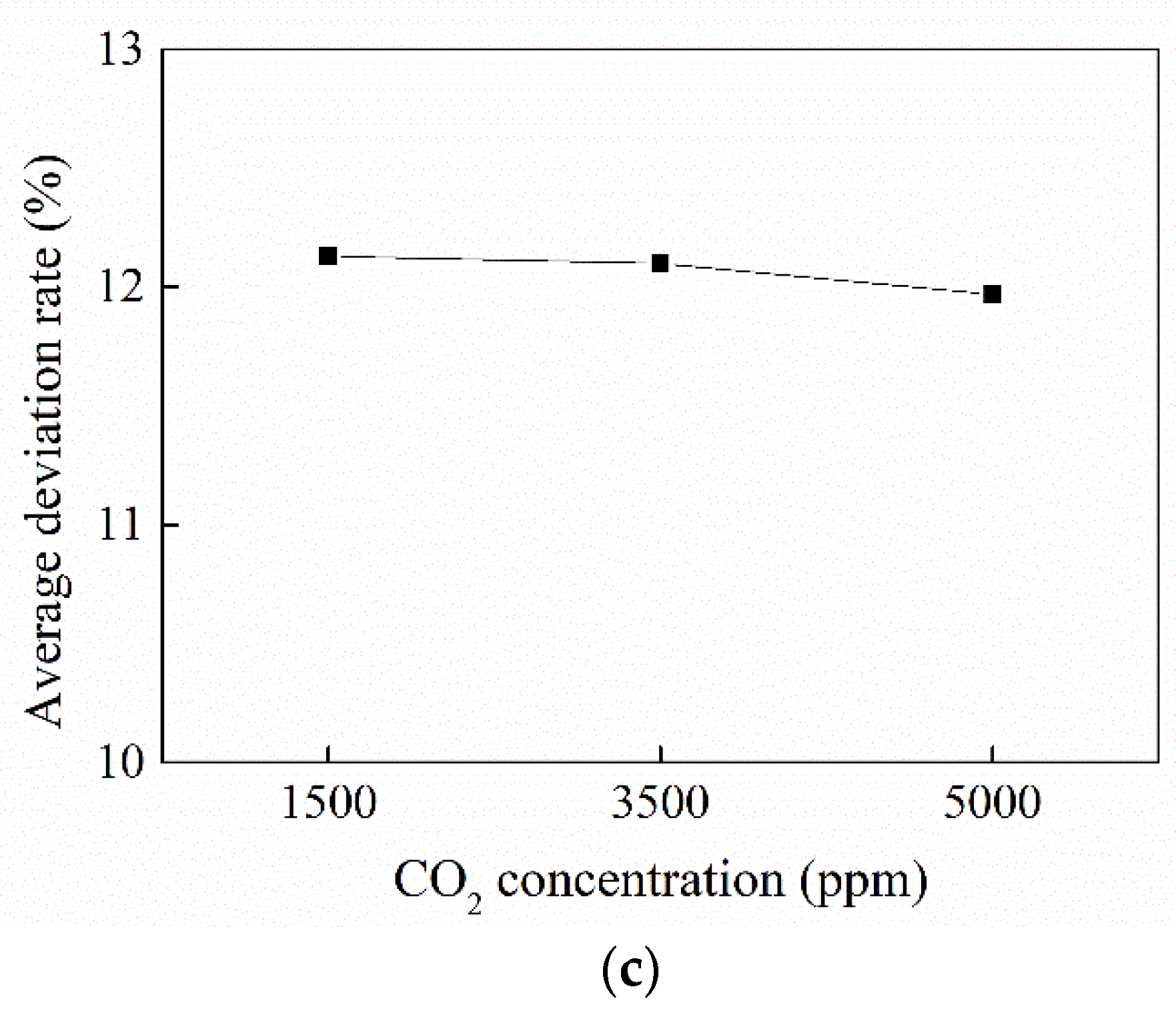
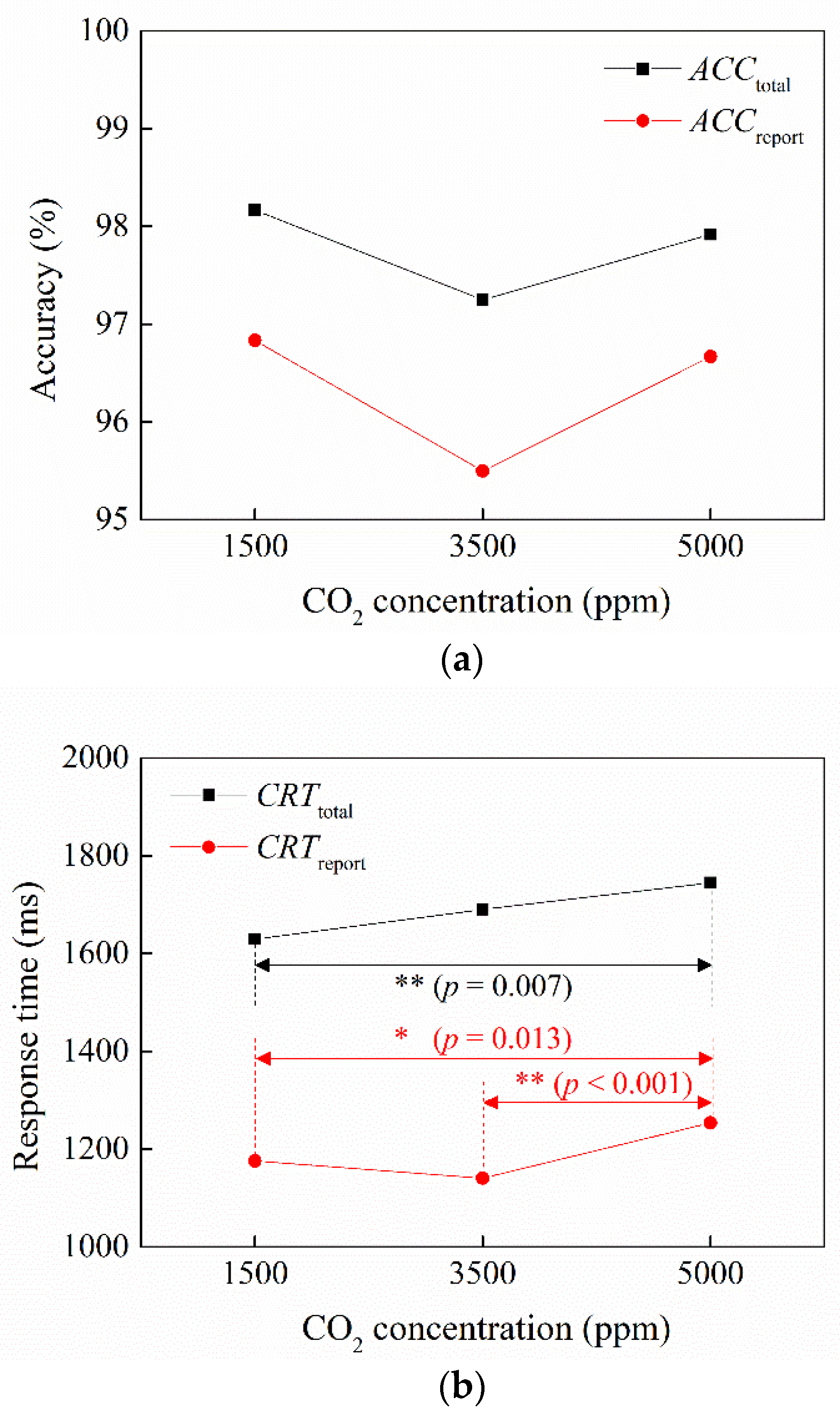



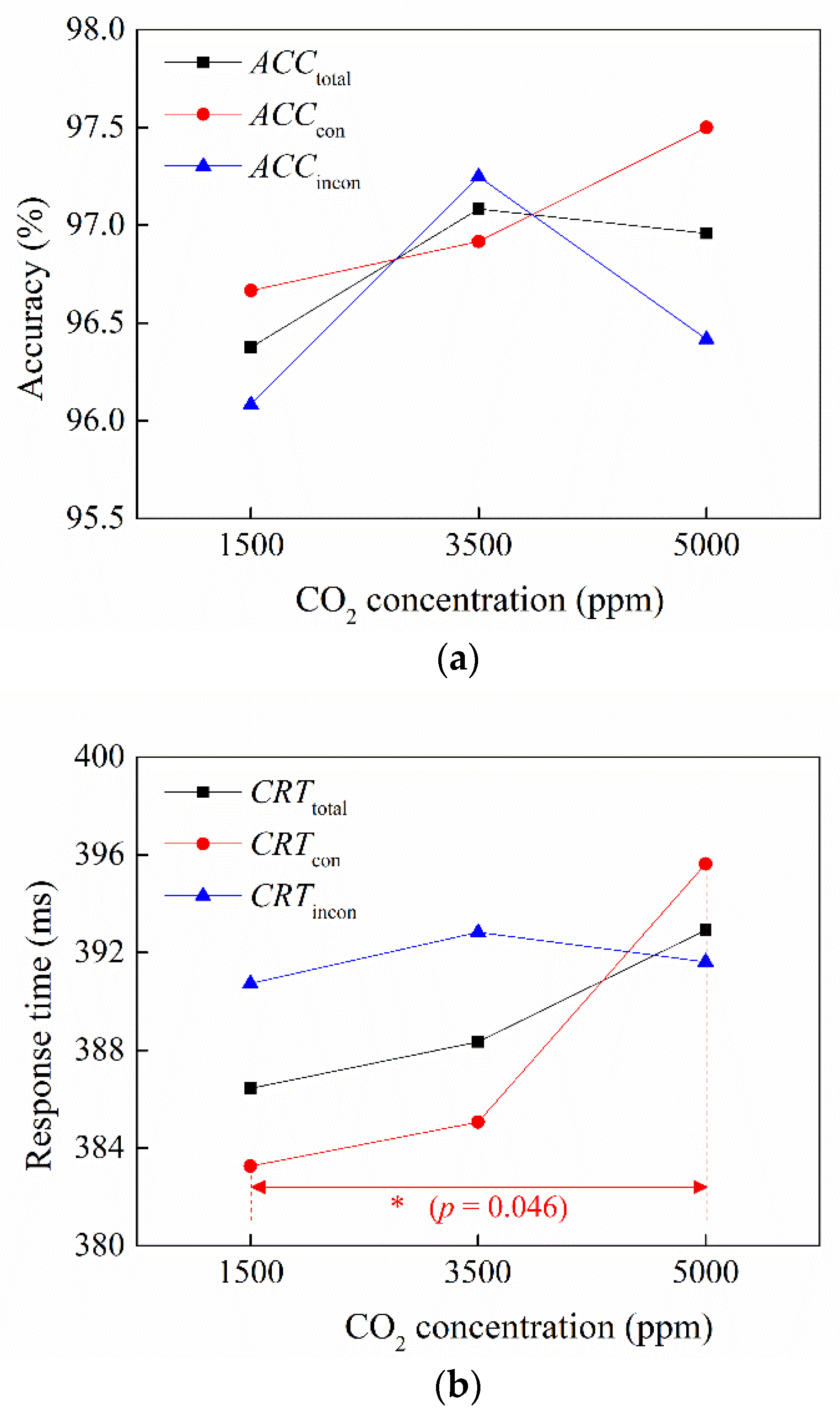
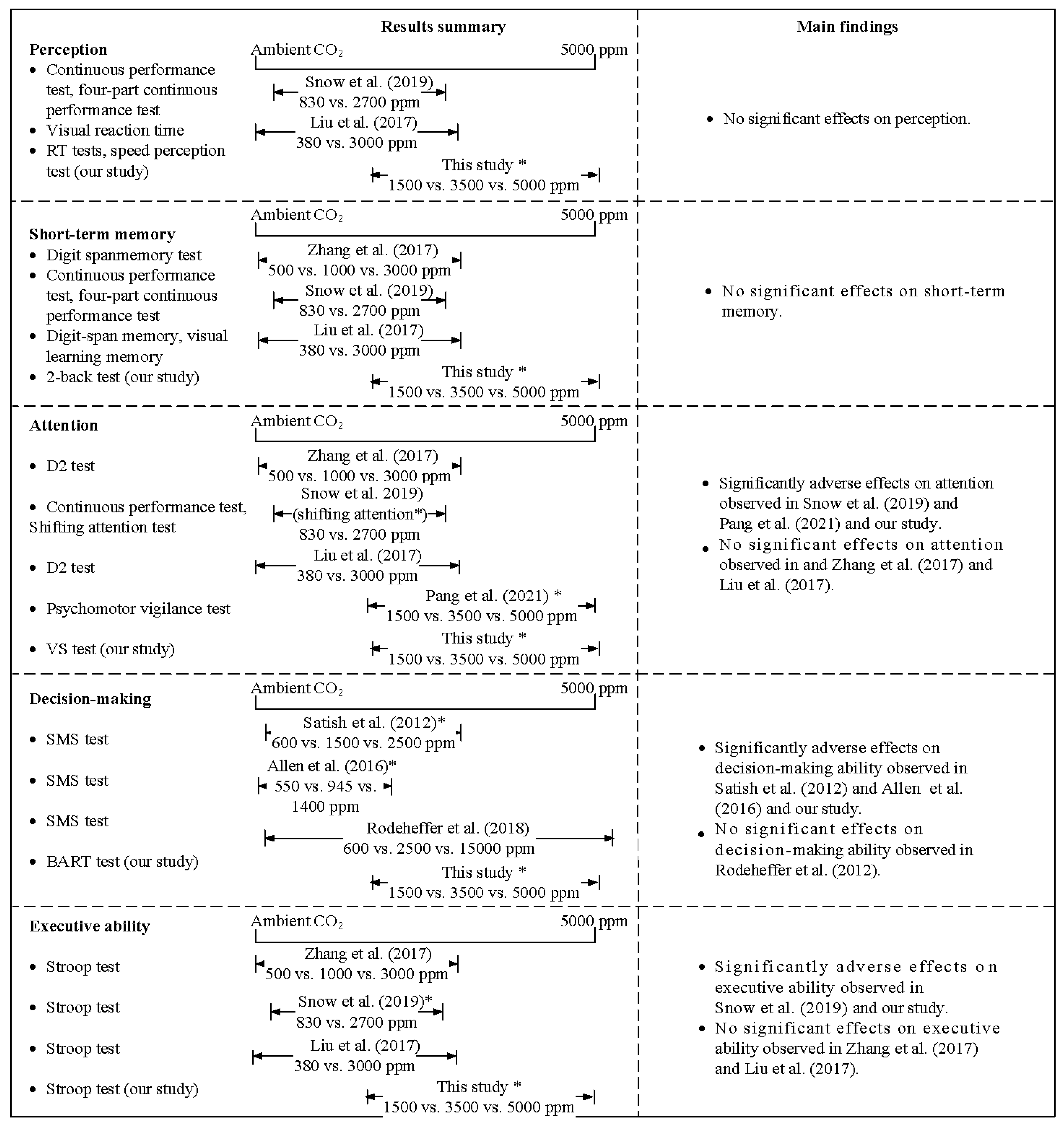
| Adjust Method | Studies | CO2 Levels | Exposure Duration | Number of Subjects | Cognitive Tests | Effects of Elevated CO2 |
|---|---|---|---|---|---|---|
| Addition of pure CO2 | Satish et al. [10] | 600 vs. 1500 vs. 2500 ppm | 150 min | 22 | SMS test | Reduced performance |
| Allen et al. [11] | 550 vs. 945 vs. 1400 ppm | One day (09:00–17:00) | 24 | SMS test | Reduced performance | |
| Rodeheffer et al. a [12] | 600 vs. 2500 vs. 15000 ppm | 125 min | 36 | SMS test | No significant effect | |
| Snow et al. [13] | 800 vs. 2700 ppm | <60 min | 31 | Stroop test; shifting attention task; continuous performance test; four-part continuous performance test. | Reduced performance of cognitive flexibility and executive function, but no significant effect on other domains. | |
| Zhang et al. [6] | 500 vs. 1000 vs. 3000 ppm | 255 min | 25 | Redirection test; digit span memory test; Stroop test; grammatical reasoning test; Stroop test with feedback; Tsai–Partington test; d2 test; arithmetical calculation. | No significant effect | |
| Zhang et al. [7] | 500 vs. 5000 ppm | 153 min | 10 | Addition test; Tsai–Partington test | No significant effect | |
| Liu et al. [14] | 380 vs. 3000 ppm b | 180 min | 12 | Mental redirection; grammatical reasoning; digit span memory; visual learning memory; number calculation; Stroop test; visual reaction time; D2 test; Tsai–Partington test. | No significant effect | |
| Bloch-Salisbury et al. [15] | 30 vs. 38 vs. 47 mmHg c | 120 min | 9 | Pattern recognition, matching-to-sample, logical reasoning, two-letter search, time estimation. | No significant effect | |
| Manipulation of ventilation rate | Maddalena et al. [16] | 900 vs. 1800 ppm | 240 min | 16 | SMS test | Reduced performance |
| Haverinen-Shaughnessy et al. [17] | From 0.9 to 7.1 L/s per person d | One day | 3109 | Mathematics test; reading test; science test | Reduced performance | |
| Bakó-Biró et al. [18] | From 1 to 8 L/s per persond | One day | 332 | Simple reaction time; choice reaction time; color word vigilance; addition reaction time; digit span memory; digit classification; digit–symbol matching; picture memory; word recognition | Reduced performance | |
| Twardella et al. [19] | 1145 vs. 2115 ppm | One day | 417 | Concentration performance; total number of characters processed; total number of error rates | Reduced performance | |
| Scully et al. [20] | 600 vs. 1200 vs. 2500 vs. 5000 ppm | 240 min | 22 | SMS tests; cognition tests | No significant effect | |
| Coley et al. [21] | 690 vs. 2909 ppm | 150 min | 18 | Picture presentation; simple reaction time; digit vigilance; choice reaction time; picture recognition; Bond–Lader visual analogue scales of mood and alertness | Reduced performance |
| Tests | Displayed Symbols | Target Symbols | Response Buttons |
|---|---|---|---|
| Simple RT | ▲ a | ▲ | “J” |
| Discriminative RT | ▲; ■ b; ● c | ▲ | “J” |
| Choice RT | ▲; ■; ● | ▲; ■; ● | “J” (▲); “F” (■); Space bar (“●”) |
Publisher’s Note: MDPI stays neutral with regard to jurisdictional claims in published maps and institutional affiliations. |
© 2022 by the authors. Licensee MDPI, Basel, Switzerland. This article is an open access article distributed under the terms and conditions of the Creative Commons Attribution (CC BY) license (https://creativecommons.org/licenses/by/4.0/).
Share and Cite
Cao, X.; Li, P.; Zhang, J.; Pang, L. Associations of Human Cognitive Abilities with Elevated Carbon Dioxide Concentrations in an Enclosed Chamber. Atmosphere 2022, 13, 891. https://doi.org/10.3390/atmos13060891
Cao X, Li P, Zhang J, Pang L. Associations of Human Cognitive Abilities with Elevated Carbon Dioxide Concentrations in an Enclosed Chamber. Atmosphere. 2022; 13(6):891. https://doi.org/10.3390/atmos13060891
Chicago/Turabian StyleCao, Xiaodong, Pei Li, Jie Zhang, and Liping Pang. 2022. "Associations of Human Cognitive Abilities with Elevated Carbon Dioxide Concentrations in an Enclosed Chamber" Atmosphere 13, no. 6: 891. https://doi.org/10.3390/atmos13060891
APA StyleCao, X., Li, P., Zhang, J., & Pang, L. (2022). Associations of Human Cognitive Abilities with Elevated Carbon Dioxide Concentrations in an Enclosed Chamber. Atmosphere, 13(6), 891. https://doi.org/10.3390/atmos13060891







